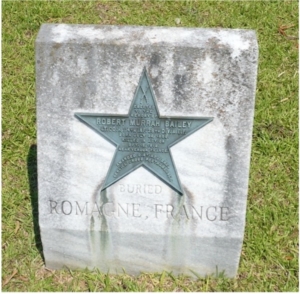Scroll of Honor – Robert Murrah Bailey
Extraordinary Heroism
Written by: Kelly Durham
Robert Murrah Bailey of Anderson attended Clemson for just one year, 1903-04.  He took the standard freshman course load and had not declared an academic major by the time he left campus.
He took the standard freshman course load and had not declared an academic major by the time he left campus.
According to his sister, Cleo, Bailey enlisted in the Army on June 6, 1916, at age 32, in order to serve along the Mexican border. In March of that year, Mexican revolutionary Pancho Villa had led a raid against Columbus, New Mexico on the US-Mexican border. The United States responded by dispatching an expeditionary force commanded by General John J. Pershing to capture Villa and bring him to justice. Although more than 140,000 National Guardsmen were called up, only two regiments were actually deployed to the border—and Villa was never captured.
Nonetheless, Bailey remained in the Army, serving with the 118th Infantry Regiment of the 30th Division, composed of National Guard units from the Carolinas, Georgia, and Tennessee. When the United States entered World War I in April of 1917, Bailey was promoted to sergeant and shipped overseas with his division. The 30th division took part in the Battle of Lys and the Somme offensive and was one of only two US divisions to break through the Hindenburg Line during the Battle of St. Quentin Canal.
Bailey’s leadership ability was recognized and he was sent to officers’ candidate school in France. His promotion to Second Lieutenant on September 30, 1918 was accompanied by a transfer to the 114th Infantry Regiment of the 29th Division. The 29th was another National Guard division. It was composed of units from New Jersey, Maryland, and Virginia, states that had fought on opposite sides during the Civil War, earning it the nickname the “Blue and Gray” division. The 29th, as part of the US First Army, participated in the Meuse-Argonne offensive. With outstanding battlefield leadership, it advanced seven kilometers in twenty-one days of combat.
While leading his platoon against an enemy position of October 12, 1918, Lieutenant Bailey was wounded.  Even so, he refused to retire from the field until his platoon reorganized and repulsed a German counterattack. Bailey’s wound proved fatal, but his “extraordinary heroism” enabled his men to hold their position. Bailey was posthumously awarded the Distinguished Service Cross, the Army’s second highest award for valor.
Even so, he refused to retire from the field until his platoon reorganized and repulsed a German counterattack. Bailey’s wound proved fatal, but his “extraordinary heroism” enabled his men to hold their position. Bailey was posthumously awarded the Distinguished Service Cross, the Army’s second highest award for valor.
Robert Murrah Bailey was survived by his mother and his sister. He is memorialized on the Tablets of the Missing at Meuse-Argonne American Military Cemetery in France and in the Westview Section of Old Silver Brook Cemetery in Anderson.
For more information on Robert Murrah Bailey see:
https://soh.alumni.clemson.edu/
For additional information about Clemson University’s Scroll of Honor visit:
https://soh.alumni.clemson.edu/scroll/robert-murrah-bailey/
